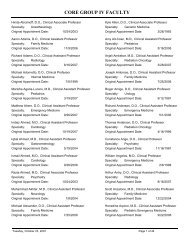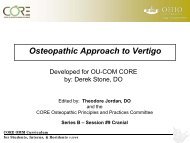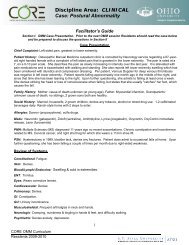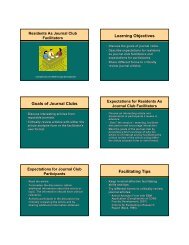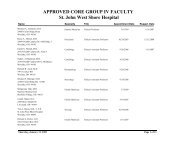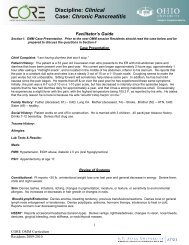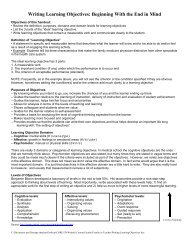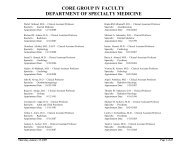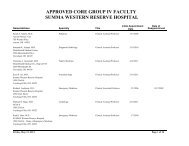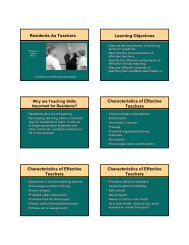Board Review I - Series A
Board Review I - Series A
Board Review I - Series A
You also want an ePaper? Increase the reach of your titles
YUMPU automatically turns print PDFs into web optimized ePapers that Google loves.
CORE OMM Curriculum<br />
<strong>Board</strong> <strong>Review</strong><br />
Developed for OUCOM CORE<br />
By: Janet Burns, D.O.<br />
Edited by: James Preston, D.O.,<br />
Clay Walsh, D.O., and the<br />
CORE Osteopathic Principles and Practices Committee<br />
<strong>Series</strong> A, B, & C - Session #5<br />
CORE OMM Curriculum<br />
for Students, Interns, & Residents ©2006
Overview<br />
• It is not the intention of this review to be comprehensive<br />
or exhaustive; that is best left to the several OMM board<br />
review books available.<br />
• The best use of your limited time is on high yield<br />
subject areas.<br />
• Current CORE residents provided the following<br />
recommendations for areas to focus on:<br />
CORE OMM Curriculum<br />
for Students, Interns, & Residents ©2006
Suggested Areas of Study<br />
1. Memorize Chapman’s Reflexes<br />
2. Dx and Tx of Sacral Dysfunctions via Muscle Energy<br />
model<br />
3. Know the difference between Direct and Indirect<br />
techniques<br />
4. Know contraindications to certain techniques<br />
CORE OMM Curriculum<br />
for Students, Interns, & Residents ©2006
Suggested Areas of Study -<br />
continued…<br />
5. Memorize Viscerosomatic reflex levels<br />
6. Memorize steps to Spencer Technique<br />
7. Diagnosis and treatment of somatic dysfunction in:<br />
cervical, thoracic, lumbar spine, sacrum, pelvis, ribs,<br />
and extremities; utilizing Direct and Indirect approaches<br />
CORE OMM Curriculum<br />
for Students, Interns, & Residents ©2006
<strong>Board</strong> <strong>Review</strong> Web Sites<br />
OMM <strong>Board</strong> <strong>Review</strong>, John D. Capobianco, D.O., F.A.A.O.<br />
http://www.md-do.org/NewOMM<strong>Board</strong>%20<strong>Review</strong>02-<br />
REV.htm<br />
- A free 32 page outline format review. Excellent for last minute<br />
studying; includes mnemonics for recall, clinical correlations,<br />
functionally relevant anatomy. Highly recommended.<br />
60 multiple choice questions with key<br />
http://www.mommd.com/comlexsample.shtml<br />
- Free, good questions, but are not labeled as to whether they are<br />
Level I, II, or III<br />
CORE OMM Curriculum<br />
for Students, Interns, & Residents ©2006
<strong>Board</strong> <strong>Review</strong> Resources<br />
OMT <strong>Review</strong> 3rd edition - A Comprehensive <strong>Review</strong> in Osteopathic<br />
Medicine; Robert G. Savarese, D.O., 2003<br />
- $36 Suitable for Levels I - III, has updated COMLEX-style<br />
questions, includes a lot more relevant anatomy than<br />
previousedition.<br />
There are a few errors, if you own this book go to:<br />
http://www.omtreview.com/errata.htm<br />
CORE OMM Curriculum<br />
for Students, Interns, & Residents ©2006
OMM Terminology<br />
Major Resource for appropriate<br />
terminology:<br />
Found in the back of<br />
Foundations for Osteopathic<br />
Medicine, 2nd Ed.<br />
CORE OMM Curriculum<br />
for Students, Interns, & Residents ©2006
Sympathetic Innervations<br />
CORE OMM Curriculum<br />
for Students, Interns, & Residents ©2006
Barriers<br />
Physiologic – limit of active motion<br />
Anatomic – limit of passive motion<br />
Elastic – range between physiologic and anatomic motion<br />
Restrictive – limit within anatomic range which decreases<br />
Physiologic range<br />
Pathologic – permanent restrictive barrier associated with<br />
pathologic change in tissue<br />
CORE OMM Curriculum<br />
for Students, Interns, & Residents ©2006
CORE OMM Curriculum<br />
for Students, Interns, & Residents ©2006<br />
Foundations for Osteopathic<br />
Medicine, 2 nd Ed., pp. 575-576
Somatic Dysfunction<br />
Definition – impaired of altered function of<br />
related components of the somatic<br />
system: skeletal, arthrodial and<br />
myofascial structures and related<br />
vascular, lymphatic and neural elements.<br />
CORE OMM Curriculum<br />
for Students, Interns, & Residents ©2006
Naming/Diagnosing<br />
Somatic Dysfunction<br />
• All somatic dysfunctions are named according to the<br />
POSITION of the dysfunctional structural element.<br />
• The POSITION of the structural element EQUALS the EASE<br />
OF MOTION of that structural element.<br />
• Therefore RESTRICTION OF MOTION of the structural<br />
element is OPPOSITE the POSTION diagnosis<br />
CORE OMM Curriculum<br />
for Students, Interns, & Residents ©2006
Somatic Dysfunction:<br />
Physical Findings<br />
(T) A. R. T.<br />
T – Tissue Texture changes<br />
A – Asymmetry<br />
R – Range of Motion (ROM)<br />
(T) – Tenderness<br />
CARDINAL INDICATOR – R.O.M.<br />
CORE OMM Curriculum<br />
for Students, Interns, & Residents ©2006
Somatic Dysfunction: Acute<br />
Acute Chronic<br />
Temperature increased cool<br />
Texture boggy, rough doughy, thin<br />
Moisture increased decreased<br />
Tension increased sl. increased<br />
Tenderness Increased less tender<br />
Edema yes no<br />
Erythema yes, stays fades quick<br />
CORE OMM Curriculum<br />
for Students, Interns, & Residents ©2006
Contraction<br />
Concentric – shortening of muscle during contraction<br />
Eccentric – lengthening of muscle during contraction<br />
Isolytic – contraction while forcing to lengthening;<br />
operator>patient<br />
Isometric – inc. tension, length constant; operator= patient<br />
Isotonic – approximation without change in tension:<br />
operator
Axes<br />
Transverse: Shoulder to shoulder<br />
Anterior-Posterior: Front to back<br />
Longitudinal: (Vertical) Head to toe<br />
CORE OMM Curriculum<br />
for Students, Interns, & Residents ©2006
Planes<br />
Transverse: Separates top from bottom<br />
Sagittal: Separates left from right<br />
Coronal: Separates front from back<br />
CORE OMM Curriculum<br />
for Students, Interns, & Residents ©2006
Flexion<br />
Def. – ends of arc approximate<br />
Sacral – base anterior<br />
Craniosacral –sacrum counter nutates<br />
(base posterior); sphenobasilar ascends<br />
Regional – cervical, thoracic, lumbar<br />
CORE OMM Curriculum<br />
for Students, Interns, & Residents ©2006
Sacral Flexion<br />
CORE OMM Curriculum<br />
for Students, Interns, & Residents ©2006<br />
Foundations for Osteopathic<br />
Medicine, 1st Ed., pp. 1130
Extension<br />
Def. – ends of arc move apart<br />
Sacral – base posterior<br />
Craniosacral – sacrum nutates (base<br />
forward) sphenobasilar descends<br />
Regional – cervical, thoracic, lumbar<br />
CORE OMM Curriculum<br />
for Students, Interns, & Residents ©2006
Sacral Extension<br />
CORE OMM Curriculum<br />
for Students, Interns, & Residents ©2006<br />
Foundations for Osteopathic<br />
Medicine, 1st Ed., pp. 1130
Fryette’s Principles<br />
Rules apply to thoracic and lumbar spine only<br />
Fryette’s I – with spine in neutral side – bending and<br />
rotation are opposite<br />
Fryette’s II – with spine hyperflexed or hyperextended<br />
sidebending and rotation are to the same side.<br />
Fryette’s III – motion in any plane of motion modifies<br />
motion in all other planes of motion.<br />
CORE OMM Curriculum<br />
for Students, Interns, & Residents ©2006
Thoracic Mechanics<br />
Non-neutral Mechanics<br />
Type II Rotation Before SB<br />
Non-neutral Mechanics<br />
Type II Rotation Before SB<br />
Kimberly Manual,<br />
millennium edition,<br />
pp. 11-12<br />
CORE OMM Curriculum<br />
for Students, Interns, & Residents ©2006
Facilitation<br />
Definition – area of impairment or restriction that<br />
develops a lower threshold for irritation and<br />
dysfunction when other areas are stimulated.<br />
Reflex hyper-excitability<br />
Hyper-irritable<br />
Hyper-responsive<br />
CORE OMM Curriculum<br />
for Students, Interns, & Residents ©2006
Spinal Motion<br />
• OA – Type I only with flexion/extension<br />
• AA – Rotation only<br />
• C2 – C7 – Type II only<br />
• Thoracic – Type I and Type II<br />
• Lumbar – Type I and Type II<br />
CORE OMM Curriculum<br />
for Students, Interns, & Residents ©2006
Gravitational Line<br />
• External auditory meatus<br />
• Lateral head of humerus<br />
• Third lumbar vertebrae (center)<br />
• Greater trochanter<br />
• Lateral condyle of knee<br />
• Lateral malleolus<br />
CORE OMM Curriculum<br />
for Students, Interns, & Residents ©2006
Gravitational Line<br />
CORE OMM Curriculum<br />
for Students, Interns, & Residents ©2006<br />
Foundations for<br />
Osteopathic Medicine, 1st<br />
Ed., pp. 1131
Iliosacral Somatic<br />
Dysfunctions<br />
• Movement of ilium on sacrum<br />
• Standing Flexion test<br />
• Landmarks: ASIS, PSIS<br />
• Anterior rotation – ASIS down, PSIS up<br />
• Posterior rotation – ASIS up, PSIS down<br />
• Inflare – ASIS in<br />
• Outflare – ASIS out<br />
• Inferior shear – ASIS down, PSIS down<br />
• Superior shear – ASIS up, PSIS up<br />
CORE OMM Curriculum<br />
for Students, Interns, & Residents ©2006
CORE OMM Curriculum<br />
for Students, Interns, & Residents ©2006<br />
DiGiovanna, 3rd Ed, p. 289
CORE OMM Curriculum<br />
for Students, Interns, & Residents ©2006<br />
DiGiovanna, 3rd Ed, p. 288
CORE OMM Curriculum<br />
for Students, Interns, & Residents ©2006<br />
DiGiovanna, 3rd Ed, p. 291
Sacral Somatic<br />
Dysfunctions<br />
• Extension – unilateral and bilateral<br />
• Flexion – unilateral and bilateral<br />
• Forward Torsions – L on L, R on R (rotation on<br />
an axis)<br />
• Backward Torsions – L on R, R on L<br />
• Sacral Shear<br />
• Anterior Sacrum (translated)<br />
• Posterior Sacrum (translated)<br />
CORE OMM Curriculum<br />
for Students, Interns, & Residents ©2006
Sacral Torsions<br />
Seated Flexion<br />
Test<br />
Axis (Oblique)<br />
Superficial<br />
Sulcus Right<br />
Superficial<br />
Sulcus Left<br />
------------------------ ------------------------ ------------------------ ------------------------<br />
Positive Right Left Right on Left Left on Left<br />
(L5)<br />
(Sacral<br />
bending)<br />
L5 Left<br />
Rotation<br />
Backward<br />
L5 Right<br />
Rotation<br />
Forward<br />
------------------------ ------------------------ ------------------------ ------------------------<br />
Positive Left Right Right on Right Left on Right<br />
(L5)<br />
(Sacral<br />
bending)<br />
CORE OMM Curriculum<br />
for Students, Interns, & Residents ©2006<br />
L5 Left<br />
Rotation<br />
Forward<br />
L5 Right<br />
Rotation<br />
Backward
Pubic Somatic Dysfunction<br />
• Motion of pubic symphysis<br />
• Landmarks: pubic bone<br />
• Dysfunctions – superior, inferior<br />
CORE OMM Curriculum<br />
for Students, Interns, & Residents ©2006
CORE OMM Curriculum<br />
for Students, Interns, & Residents ©2006<br />
DiGiovanna, 3rd Ed, p. 291
Sacral Somatic<br />
Dysfunctions<br />
• Seated flexion test<br />
• Sphinx test (lumbar extension)<br />
• Spring test<br />
• 2 Landmarks – Sacral Sulcus – ILA<br />
(inferior lateral angle)<br />
CORE OMM Curriculum<br />
for Students, Interns, & Residents ©2006
CORE OMM Curriculum<br />
for Students, Interns, & Residents ©2006<br />
Glossary of Osteopathic Terminology
Sacral Motion<br />
7 axes of motion<br />
– Vertical – rotation<br />
– A/P – sidebending<br />
– 2 Obliques (diagonals) R and L – torsions<br />
– 3 Transverse axes – flexion and extension<br />
• Superior transverse - respiratory axis<br />
• Middle transverse - postural axis<br />
• Inferior Transverse – Innominate rotation axis<br />
CORE OMM Curriculum<br />
for Students, Interns, & Residents ©2006
Sacral Axes<br />
1 Longitudinal axis<br />
1 Anterior-posterior axis<br />
2 Oblique axes<br />
• Right and Left<br />
3 Transverse axes<br />
• Superior, Middle, and<br />
Inferior<br />
CORE OMM Curriculum<br />
for Students, Interns, & Residents ©2006<br />
DiGiovanna, 3rd Ed, p. 287
Sacral Axes<br />
3 Transverse Axes<br />
– Superior: Respiratory<br />
axis<br />
• Motion relative to the pull<br />
of the dura occurs around<br />
this axis<br />
– Middle: Postural axis<br />
• Bilateral Flexion &<br />
Extension occur around<br />
this axis (motion during<br />
flexion/extension of spine)<br />
– Inferior: Innominate<br />
rotation axis<br />
CORE OMM Curriculum<br />
for Students, Interns, & Residents ©2006<br />
DiGiovanna, 3rd Ed, p. 287
ME Sacral Diagnosis -Tips<br />
Similar to algebra, you will be expected to solve the equation for the<br />
unknown, you need to know the “rules” and algorhythms:<br />
(+) Spring or Sphinx (prone backward bending) tests reflect an<br />
extended sacral base (unilateral or bilateral extensions or backward<br />
torsions)<br />
Sacral torsion “rules” of L5 on S1<br />
– Sacrum rotates opposite L5<br />
– When L5 is sidebent, it forms an oblique axis on that side<br />
– The (+) seated flexion test is found on the side opposite the<br />
oblique axis<br />
– Forward Torsions occur in Neutral (Type 1) mechanics<br />
– Backward torsions occur in Non-neutral (Type 2) mechanics<br />
CORE OMM Curriculum<br />
for Students, Interns, & Residents ©2006
ME Sacral Diagnosis -Tips<br />
Using these rules, if you are given L5 FrSr:<br />
– There will be a (+) flexion test on L, sacrum rotated L on R<br />
oblique axis<br />
– You then extrapolate that this is a backward torsion (because<br />
forward torsions are named same on same, i.e. L on L,<br />
Backward torsions are vice versa)<br />
– Therefore the Spring or Sphinx tests would be (+) reflecting the<br />
extended (posterior) sacral base on the L<br />
– Deep Sulcus (DS) is therefore on the R, Posterior /Inferior ILA is<br />
on the L<br />
CORE OMM Curriculum<br />
for Students, Interns, & Residents ©2006
Forward Torsions - <strong>Review</strong><br />
Findings for Left on Left:<br />
– (+) Standing flexion test on R<br />
– Deep sacral sulcus (DS) on R<br />
– Posterior/Inferior ILA on L<br />
– (-) Spring / Sphinx Test<br />
– Sacrotuberous Ligament taut<br />
on the L<br />
CORE OMM Curriculum<br />
for Students, Interns, & Residents ©2006<br />
Mitchell, The Muscle Energy Manual, Volume III, p. 62
Forward Torsions: Causes<br />
Forward Torsions<br />
• Occurs when lumbar spine is in neutral<br />
mechanics<br />
• Exaggerated ambulation mechanics<br />
Sacrotuberous Ligament is taut on side of<br />
Posterior/Inferior ILA<br />
CORE OMM Curriculum<br />
for Students, Interns, & Residents ©2006
Backward Torsions -<br />
<strong>Review</strong><br />
Findings for Right on Left:<br />
– (+) Standing flexion test on R<br />
– Deep sacral sulcus (DS) on L<br />
– Posterior/Inferior ILA on R<br />
– (+) Spring / Sphinx Test<br />
– Sacrotuberous Ligament taut<br />
on the R<br />
CORE OMM Curriculum<br />
Mitchell, The Muscle Energy Manual, Volume III, p. 62<br />
for Students, Interns, & Residents ©2006
Backward Torsions: Causes<br />
Backward Torsions<br />
How do these occur?<br />
• Physiologically during Non-Neutral Lumbar<br />
Mechanics<br />
Is backward torsional motion always<br />
dysfunctional?<br />
• No, only if it can’t return to neutral<br />
CORE OMM Curriculum<br />
for Students, Interns, & Residents ©2006
Backward Torsion:<br />
possible mechanism<br />
Mitchell, The Muscle Energy Manual, Volume III, p. 64<br />
CORE OMM Curriculum<br />
for Students, Interns, & Residents ©2006
L. Unilateral Sacral<br />
Flexion<br />
• L half of Sacrum has<br />
moved forward & down<br />
relative to R<br />
•(-) Sphinx test<br />
•(+) Seated flexion test on L<br />
•Sacrotuberous lig. taut on L<br />
CORE OMM Curriculum<br />
for Students, Interns, & Residents ©2006<br />
Mitchell, The Muscle Energy Manual, Volume III, p. 60
Compare<br />
CORE OMM Curriculum<br />
for Students, Interns, & Residents ©2006<br />
Mitchell, The Muscle Energy Manual, Volume III, p. 61
Unilateral Sacral<br />
Flexions / Extensions<br />
Deep Sulcus and Posterior/ Inferior ILA on Same side (i.e. both on L,<br />
could be L Flex or R Ext)<br />
What separates a L sacral Flexion from a R sacral<br />
Extension is:<br />
• the Sphinx test: (-) in flex (+) in ext<br />
• or the Seated flexion test (+) R on R Ext, (+) L on L Flex<br />
Some find it easier to think of it as a shear or combination of Sidebending<br />
and Rotational strains:<br />
• Sidebending and Rotation occur to opposite sides<br />
• Caused by unbalanced sacral base loading during trunk<br />
sidebending- same mech. that can cause innominate upslip, but<br />
trunk is sidebent, not upright<br />
CORE OMM Curriculum<br />
for Students, Interns, & Residents ©2006
Bilateral Flexion / Extension<br />
Extension Dysfunction<br />
PSIS’s level<br />
ILA’s level<br />
Bilateral shallow<br />
(posterior) sacral sulci<br />
(+) Spring / Sphinx test<br />
(restricted motion)<br />
Flexion Dysfunction<br />
PSIS’s level<br />
ILA’s level<br />
Bilateral deep (anterior)<br />
sacral sulci<br />
(-) Spring / Sphinx test<br />
(unrestricted motion)<br />
CORE OMM Curriculum<br />
for Students, Interns, & Residents ©2006<br />
DiGiovanna, 2nd Ed
Causes of Bilateral Sacral<br />
Flexion / Extension<br />
Bilateral Sacral<br />
Extension<br />
• Improper lifting techniques<br />
• Fall in a seated position<br />
Bilateral Sacral<br />
Flexion<br />
• Extremely common<br />
postpartum<br />
• Arched while holding<br />
heavy load<br />
CORE OMM Curriculum<br />
for Students, Interns, & Residents ©2006
Optional Activities<br />
1. Practice Diagnosing and Treating Sacral Dysfunctions<br />
according to ME model…<br />
2. Some Sacral ME treatments commonly found on exams<br />
are included in the following slides…<br />
CORE OMM Curriculum<br />
for Students, Interns, & Residents ©2006
1 of 3<br />
ME: Forward Torsion –<br />
Left on Left<br />
• Operator flexes the hips to at<br />
least 90 degrees, (Non-Neutral)<br />
guides the knees to the right side<br />
of the table and facilitates lumbopelvic<br />
rotation right.<br />
Pt.: Prone<br />
• Operator stands on the right side<br />
• Pt. is instructed to allow knees to<br />
be flexed & raise right hip.<br />
CORE OMM Curriculum<br />
for Students, Interns, & Residents ©2006<br />
Kimberly Manual, p.203-204
2 of 3<br />
Forward Torsion –<br />
Left on Left<br />
• Sidebending is introduced by<br />
supporting the pt’s. knees on the<br />
operator’s thighs and lowering the<br />
feet off the table<br />
• Localized to L-S Junction<br />
• Pt is instructed to inhale, then<br />
reach to the floor with the right<br />
upper arm during exhalation while<br />
monitoring L5<br />
• Operator may assist this motion<br />
by pushing the shoulder toward<br />
the floor to achieve rotation of L5<br />
left<br />
CORE OMM Curriculum<br />
for Students, Interns, & Residents ©2006<br />
Kimberly Manual, p.203-204
3 of 3<br />
Forward Torsion –<br />
Left on Left<br />
• Pt. is instructed to lift the feet<br />
toward the ceiling against<br />
isometric resistance<br />
• Sufficient force is needed to feel<br />
the localization at of the muscle<br />
effort to the right sacral base.<br />
• Operator may additionally contact<br />
the spinous process of L5 to<br />
encourage rotation of that vertebra<br />
to the left.<br />
• This is usually not necessary. It<br />
is important to monitor the right<br />
sacral base simultaneously.<br />
CORE OMM Curriculum<br />
for Students, Interns, & Residents ©2006<br />
• Hold for 3-5 seconds<br />
• Relax about 2 seconds, breathe<br />
as a reminder!<br />
• Repeat<br />
• Retest<br />
Kimberly Manual, p.203-204
1 of 4<br />
ME: Right on<br />
Left Sacral Torsion<br />
• Patient in left lateral recumbent<br />
position<br />
• The right lower extremity is<br />
flexed until the vector of force is<br />
palpated at the right sacral base<br />
by the monitoring fingers<br />
• The right knee is supported<br />
between the operator’s two thighs<br />
CORE OMM Curriculum<br />
for Students, Interns, & Residents ©2006<br />
Courtesy of David C. Eland, DO,FAAO -<br />
OUCOM
2 of 4<br />
Right on Left<br />
Sacral Torsion - continued<br />
The left lower extremity<br />
is extended by the<br />
operator<br />
– This encourages<br />
sacral base<br />
anterior motion<br />
CORE OMM Curriculum<br />
for Students, Interns, & Residents ©2006<br />
Courtesy of David C. Eland, DO,FAAO - OUCOM
3 of 4<br />
Right on Left<br />
Sacral Torsion - continued<br />
Trunk rotation to the right is<br />
accomplished via a pull through<br />
the left upper extremity.<br />
- This right rotation is carried down<br />
through L5, which, in turn,<br />
encourages the right sacral base to<br />
move anterior.<br />
Continue to support the right knee<br />
throughout the procedure<br />
– This helps maintain the<br />
fulcrum for change.<br />
CORE OMM Curriculum<br />
for Students, Interns, & Residents ©2006<br />
Courtesy of David C. Eland, DO,FAAO - OUCOM
4 of 4<br />
Right on Left<br />
Sacral Torsion - continued<br />
-Carry the right ankle toward the floor<br />
-The patient is instructed to try to lift<br />
the ankle toward the ceiling –<br />
isometric contraction with operator<br />
resistance<br />
• This gaps the sacroiliac and<br />
allows the other forces<br />
acting upon the sacrum to<br />
carry the right base anterior.<br />
-Relax<br />
-Reposition ankle & knee according to<br />
response noted by monitoring hand<br />
-Repeat, Retest<br />
CORE OMM Curriculum<br />
for Students, Interns, & Residents ©2006<br />
Courtesy of David C. Eland, DO,FAAO - OUCOM
L. Unilateral Sacral Flexion;<br />
(Sacrum Sidebent L Rotated R)<br />
ME, LVMA<br />
- Patient prone, Doc on side of Dysfunction<br />
- ABduct & Int Rot Hip to gap SI Joint, brace with docs body<br />
- Apply anterior pressure to Inferior/Posterior ILA to move (DS) base<br />
posteriorly; Cephalad to side bend it Right. Can spring it or use<br />
respiratory assist: Pt inhales deeply and holds-should feel Base move<br />
posterior<br />
Kimberly Manual, p.214<br />
CORE OMM Curriculum<br />
for Students, Interns, & Residents ©2006
L. Unilateral Sacrum Extended;<br />
LVMA<br />
•Heel of Caudad hand on<br />
Inferior Ischial Tuberosity<br />
•Hypothenar eminence of<br />
cephalad hand on Sacral Base<br />
•Carry Ischial Tuberosity<br />
SUPERIORLY<br />
– This produces an anterior<br />
rotation of the innominate<br />
to help engage the barrier<br />
•Carry Sacral Base Anterior and<br />
Inferior to barrier<br />
CORE OMM Curriculum<br />
for Students, Interns, & Residents ©2006<br />
Kimberly Manual, p.214
1 of 2<br />
ME: Bilateral Sacral Flexion<br />
Pt. Sits with feet & knees<br />
apart<br />
Operator:<br />
Heel of sacral hand contacts<br />
below the middle transverse<br />
axis<br />
Cephalad hand monitors &<br />
maintains trunk flexion via<br />
contact with the mid to lower<br />
thoracic area<br />
CORE OMM Curriculum<br />
for Students, Interns, & Residents ©2006<br />
Kimberly Manual, p.192
2 of 2<br />
Bilateral Sacral Flexion<br />
- Pt. is instructed to ‘push<br />
the lumbosacral junction<br />
posterior’ while operator<br />
maintains isometric<br />
counterforce<br />
-3-5 second contraction<br />
followed by about 2 second<br />
relaxation<br />
-Repeat<br />
-Recheck<br />
CORE OMM Curriculum<br />
for Students, Interns, & Residents ©2006<br />
Kimberly Manual, p.192
ME: Bilateral Sacrum<br />
Extended<br />
Pt. Seated on stool<br />
– Feet together, knees apart,<br />
arms crossed<br />
Operator:<br />
– Hand on sacral base<br />
– Other hand across chest<br />
CORE OMM Curriculum<br />
for Students, Interns, & Residents ©2006<br />
Pt. Positioning Refinement: Pt. Is instructed<br />
to arch the back by pushing the abdomen<br />
toward the knees<br />
Operator maintains compressive force on<br />
sacral base<br />
3-5 repetitions of pt. Attempted trunk flexion<br />
(isometric), relax between efforts<br />
Innate Force:<br />
Exhalation assists in<br />
Carrying the sacral<br />
base anterior<br />
Greenman, 3 rd Ed., p. 383
Ribs<br />
Atypical – Ribs 1, 2, 10, 11, 12<br />
Typical – Ribs 3 – 9<br />
Pump handle – upper ribs<br />
Mixed – middle ribs<br />
Bucket handle – lower ribs (to rib 10)<br />
Caliper – Ribs 11 and 12<br />
CORE OMM Curriculum<br />
for Students, Interns, & Residents ©2006
CORE OMM Curriculum<br />
for Students, Interns, & Residents ©2006<br />
Foundations for Osteopathic Medicine, 1st Ed., pp. 1128
CORE OMM Curriculum<br />
for Students, Interns, & Residents ©2006<br />
Foundations for Osteopathic Medicine, 1st Ed., pp. 1128
Rib Somatic Dysfunction<br />
• Exhalation Rib – free motion in exhalation<br />
other: exhalation strain, depressed rib, anterior<br />
rib tenderpoint<br />
• Inhalation Rib – free motion in inhalation other:<br />
inhalation strain, elevated rib, posterior rib<br />
tenderpoint<br />
CORE OMM Curriculum<br />
for Students, Interns, & Residents ©2006
CORE OMM Curriculum<br />
for Students, Interns, & Residents ©2006<br />
Foundations for Osteopathic Medicine, 1st Ed., pp. 1128
CORE OMM Curriculum<br />
for Students, Interns, & Residents ©2006<br />
Foundations for Osteopathic Medicine, 1st Ed., pp. 1128
Rule of Three’s (Thorax)<br />
Refers to the position of a spinous process relative to its<br />
vertebral segment level.<br />
T1 –T3–same level<br />
T4 – T6 – ½ segment below<br />
T7 – T9 – 1 segment below<br />
T10 – 1 segment below<br />
T11 – ½ segment below<br />
T12 – same level<br />
CORE OMM Curriculum<br />
for Students, Interns, & Residents ©2006
What are Chapman’s<br />
Reflexes?<br />
A system of predictable anterior and posterior fascial<br />
tissue texture abnormalities described in the 1920’s<br />
by Frank Chapman, D.O.:<br />
• They indicate increased functional activity of the sympathetic<br />
nervous system<br />
• Thought to reflect visceral dysfunction or pathology<br />
• They follow Sympathetic afferent pathways<br />
– Do NOT reflect parasympathetic nervous system<br />
• Treating them may alter sympathetic influences on the<br />
corresponding viscera<br />
CORE OMM Curriculum<br />
for Students, Interns, & Residents ©2006
Chapman’s vs.<br />
Viscerosomatic Reflexes<br />
Similarities<br />
Differences<br />
– Somatic result of a visceral<br />
input<br />
– Will return if underlying<br />
problem is not corrected<br />
– Tx of Somatic Component<br />
can improve Visceral<br />
homeostasis<br />
– Chapman’s are<br />
neurolymphatic reflexes;<br />
viscerosomatic are neural<br />
reflexes<br />
– Chapman’s manifest in the<br />
same place all of the time;<br />
viscerosomatic manifest<br />
within a range of vertebral<br />
segments, and of varying<br />
intensity<br />
CORE OMM Curriculum<br />
for Students, Interns, & Residents ©2006
Chapman’s Reflexes:<br />
Anterior Points<br />
Kuchera ML, Kuchera WA.<br />
Osteopathic Considerations in<br />
Systemic Dysfunction. 2nd<br />
ed. Columbus OH: Greyden<br />
Press: 1994: pp. 232-3.<br />
or<br />
Ward R. Foundations for<br />
Osteopathic Medicine. 2nd<br />
ed. Philadelphia: Williams &<br />
Wilkins: 2002: pp. 1053-4.<br />
CORE OMM Curriculum<br />
for Students, Interns, & Residents ©2006
Chapman’s Reflexes:<br />
Posterior Points<br />
Kuchera ML, Kuchera WA.<br />
Osteopathic Considerations<br />
in Systemic Dysfunction.<br />
2nd ed. Columbus OH:<br />
Greyden Press: 1994: pp.<br />
232-3.<br />
or<br />
Ward R. Foundations for<br />
Osteopathic Medicine. 2nd<br />
ed. Philadelphia: Williams &<br />
Wilkins: 2002: pp. 1053-4.<br />
CORE OMM Curriculum<br />
for Students, Interns, & Residents ©2006
Craniosacral<br />
Discoverer – Sutherland<br />
Midline Bones – Flex/Extend<br />
Paired Bones – External/Internal Rotation<br />
Inspiration – Cranial Flexion + Ext. Rotation<br />
Expiration – Cranial Extension + Internal Rotation<br />
CV4 – Gently hold cranial extension forces CSF distally<br />
Still point - Sutherland<br />
CORE OMM Curriculum<br />
for Students, Interns, & Residents ©2006
Cranial Concept:<br />
5 Components<br />
1. The intrinsic motility of the brain and spinal cord<br />
2. The fluctuation of the cerebrospinal fluid<br />
3. The mobility of the intracranial and intraspinous<br />
membrane as functional system known as the<br />
reciprocal tension membrane<br />
4. The sutural mobility of the cranial bones<br />
5. The involuntary movement of the sacrum between the<br />
ilia<br />
CORE OMM Curriculum<br />
for Students, Interns, & Residents ©2006
CORE OMM Curriculum<br />
for Students, Interns, & Residents ©2006<br />
Foundations for Osteopathic Medicine, 1st Ed.
?<br />
CORE OMM Curriculum<br />
for Students, Interns, & Residents ©2006<br />
Foundations for Osteopathic Medicine, 1st Ed.
Flexion at SBS<br />
?<br />
CORE OMM Curriculum<br />
for Students, Interns, & Residents ©2006<br />
Foundations for Osteopathic Medicine, 1st Ed.
Cranial Flexion<br />
Flexion Phase: Sphenobasilar<br />
symphysis rises pulling the sacral base<br />
superior/posterior<br />
CORE OMM Curriculum<br />
for Students, Interns, & Residents ©2006<br />
Magoun, Osteopathy in the Cranial Field, 3 rd Edition, p. 39
Cranial Flexion/Extension<br />
CORE OMM Curriculum<br />
for Students, Interns, & Residents ©2006<br />
Upledger, Cranial Sacral Therapy
Strain Patterns<br />
There are essentially six strain patterns to concern yourself<br />
with. They are:<br />
1. Flexion & Extension<br />
2. Torsion<br />
3. Sidebending, Rotation<br />
4. Vertical Strain<br />
5. Lateral Strain<br />
6. Compression<br />
CORE OMM Curriculum<br />
for Students, Interns, & Residents ©2006
Flexion and Extension<br />
CORE OMM Curriculum<br />
for Students, Interns, & Residents ©2006<br />
Pratt-Harrington,<br />
“Except for OMT”, , p 37
Torsion<br />
CORE OMM Curriculum<br />
for Students, Interns, & Residents ©2006<br />
Pratt-Harrington,<br />
“Except for OMT”, , p 38
Sidebending/Rotation<br />
CORE OMM Curriculum<br />
for Students, Interns, & Residents ©2006<br />
Pratt-Harrington,<br />
“Except for OMT”, , p 39
Vertical Strain<br />
CORE OMM Curriculum<br />
for Students, Interns, & Residents ©2006<br />
Pratt-Harrington,<br />
“Except for OMT”, , p 40
Lateral Strain<br />
CORE OMM Curriculum<br />
for Students, Interns, & Residents ©2006<br />
Pratt-Harrington,<br />
“Except for OMT”, , p 41
SBS Compression<br />
CORE OMM Curriculum<br />
for Students, Interns, & Residents ©2006<br />
Foundations for Osteopathic Medicine, 1st Ed.
Direct Techniques<br />
HVLA<br />
LVLA<br />
Muscle Energy - Mitchell<br />
CORE OMM Curriculum<br />
for Students, Interns, & Residents ©2006
Indirect Techniques<br />
Counterstrain – Lawrence Jones<br />
Facilitated Positional Release –<br />
Schiowitz<br />
Functional Technique<br />
CORE OMM Curriculum<br />
for Students, Interns, & Residents ©2006
Direct/Indirect Techniques<br />
Myofascial<br />
Cranial – Sutherland<br />
Still Technique<br />
CORE OMM Curriculum<br />
for Students, Interns, & Residents ©2006
Facilitated Positional<br />
Release<br />
• Schiowitz<br />
• Patient relaxed<br />
• Flatten A/P curve<br />
• Place in position of ease<br />
• Facilitated force – compression, traction, torsion<br />
• Hold 3 – 4 seconds<br />
CORE OMM Curriculum<br />
for Students, Interns, & Residents ©2006
Counterstrain<br />
Lawrence Jones, D.O.<br />
• Patient relaxed<br />
• Position of least discomfort (70 % better)<br />
• Hold 90 sec. (120 sec. – ribs)<br />
• Slowly release<br />
CORE OMM Curriculum<br />
for Students, Interns, & Residents ©2006
Contraindications<br />
There is no single definitive reference for these:<br />
The Savarese review book has lists that are compiled from major<br />
Osteopathic texts including: DiGiovanna, Greenman, Foundations,<br />
and Kuchera & Kuchera.<br />
Know the absolute vs. relative contraindications for different<br />
techniques, when noted.<br />
– Not all techniques have nice, clear-cut lists of relative vs.<br />
absolute.<br />
– <strong>Board</strong> questions tend to ask about contraindications that are<br />
commonly agreed upon, not the controversial ones.<br />
CORE OMM Curriculum<br />
for Students, Interns, & Residents ©2006
Contraindications: HVLA<br />
Absolute<br />
Osteoporosis<br />
Osteomyelitis, incl. Pott’s Dz<br />
Bone Metastasis<br />
Fractures in area of thrust<br />
Tx of C-Spine in patients w/<br />
severe RA or Down’s<br />
Syndrome<br />
– Weakened ligament of<br />
Dens<br />
Relative<br />
Acute Whiplash<br />
Pregnancy<br />
Post- surgical conditions<br />
Herniated nucleus pulposus<br />
Hemophiliacs,<br />
anticoagulated patients<br />
Vertebral artery ischemia<br />
CORE OMM Curriculum<br />
for Students, Interns, & Residents ©2006
Contraindications: ME<br />
Absolute<br />
• Fractures & severe<br />
neuromuscular injuries to<br />
potential Tx sites<br />
• Inability of patient to<br />
cooperate<br />
Relative<br />
• Patients w/ low vitality,<br />
who could be further<br />
compromised by active<br />
muscular exertion:<br />
– Post surgical<br />
– ICU /CCU patients<br />
– These pts may tolerate<br />
gentler forms of ME<br />
such as reciprocal<br />
inhibition<br />
CORE OMM Curriculum<br />
for Students, Interns, & Residents ©2006
Contraindications:<br />
Counterstrain<br />
Absolute<br />
Relative<br />
Inability to relax muscles<br />
– Disease<br />
• Physical<br />
• Emotional<br />
– Severe pain<br />
– Age<br />
– Drugs<br />
Severely debilitated patient<br />
– Decrease DOSAGE<br />
(intensity of treatment)<br />
• Do less than six points<br />
• Position for less than<br />
maximal relief of TP<br />
- Avoid positions of<br />
extreme thoracolumbar<br />
flexion in osteoporotic<br />
patients<br />
CORE OMM Curriculum<br />
for Students, Interns, & Residents ©2006
Osteopathy in the Cranial Field:<br />
Indications & Contraindications<br />
Indirect Action / Exaggeration<br />
Commonly used in ages 5 thru adult<br />
– Overriding sutures<br />
NOT used in:<br />
– In acute head trauma when exaggeration could cause<br />
or increase intracranial bleeds<br />
– In young children who do not yet have a developed<br />
sutural pattern<br />
CORE OMM Curriculum<br />
for Students, Interns, & Residents ©2006
Osteopathy in the Cranial Field:<br />
Indications & Contraindications<br />
Direct Action<br />
Recommended in ages 5 and under<br />
used in:<br />
– Overriding sutures<br />
– In acute head trauma when exaggeration could cause<br />
or increase intracranial bleeds<br />
– In young children who don’t have a developed sutural<br />
pattern yet<br />
NOT used when it could cause or increase intracranial<br />
bleeds, or tissue trauma.<br />
CORE OMM Curriculum<br />
for Students, Interns, & Residents ©2006
Osteopathy in the Cranial Field:<br />
Contraindications:<br />
Absolute<br />
Relative<br />
• Acute intracranial bleed<br />
• Increased intracranial<br />
pressure<br />
• Skull fracture<br />
• Traumatic brain injury<br />
• In patients with Hx of<br />
seizures or dystonia, great<br />
care must be used in order<br />
to not exacerbate any<br />
neurological Sx<br />
CORE OMM Curriculum<br />
for Students, Interns, & Residents ©2006
Contraindications - Articulatory<br />
Techniques: Springing, Low<br />
Velocity/Moderate Amplitude (LVMA)<br />
Contraindications:<br />
• Acutely inflamed joints, especially if due to infection or<br />
fracture<br />
• Recent surgery to Tx area<br />
• Repeated hyper-rotation of an extended upper Cervical<br />
spine may damage the Vertebral Art.<br />
CORE OMM Curriculum<br />
for Students, Interns, & Residents ©2006
Contraindications: Facilitated<br />
Positional Release (FPR)<br />
None listed in Savarese or the FPR chapter in Foundations 2 nd ed..<br />
If it shows up on boards, apply fundamental principles to reason it out:<br />
– It uses compression (usually) or distraction as its activating<br />
force; after putting patient in position of ease<br />
– Think of things that can’t tolerate compression, i.e. injured discs,<br />
etc.<br />
– Therefore it would not be the Tx of choice in an acute whiplash<br />
injury<br />
CORE OMM Curriculum<br />
for Students, Interns, & Residents ©2006
Contraindications:<br />
Myofascial Release<br />
No absolute vs. relative, no discussion found about<br />
Direct vs. Indirect contraindications<br />
In general:<br />
– Nearby surgical wound or infection<br />
– Fracture<br />
Specific Contraindications to Celiac, Inf., & Sup.<br />
Mesenteric Ganglia releases:<br />
– Aortic Aneurysm<br />
– Nearby surgical wound<br />
CORE OMM Curriculum<br />
for Students, Interns, & Residents ©2006
Contraindications:<br />
Lymphatic Techniques<br />
No clear distinction currently made between Relative and<br />
Absolute.<br />
– The term “Absolute” is therefore generally not used<br />
with regard to Lymphatic Treatment.<br />
Be aware of the difference between Lymphatic “Pump” and<br />
other lymphatic techniques.<br />
CORE OMM Curriculum<br />
for Students, Interns, & Residents ©2006
Contraindications:<br />
Lymphatics<br />
There are many different kinds of Lymphatic Techniques;<br />
rather than try to memorize a separate contraindication<br />
list for every one, it is simpler to think about what<br />
category a specific technique falls under.<br />
– i.e., rib raising is a direct Articulatory technique and<br />
therefore shares the same list of contraindications<br />
– redoming the diaphragm shares those of the other<br />
direct myofascial release techniques<br />
CORE OMM Curriculum<br />
for Students, Interns, & Residents ©2006
Relative Contraindications:<br />
Lymphatic Pump Tx<br />
• Fractures<br />
• Bacterial infections with a temp > 102 o F<br />
• Abscesses or localized infection<br />
• Thromboses<br />
• Fragility of nearby organs<br />
• Certain stages of Carcinoma, or Malignancy of Lymphatic System<br />
– Controversial Area<br />
– No clinical evidence to support this as a contraindication<br />
CORE OMM Curriculum<br />
for Students, Interns, & Residents ©2006
Relative Contraindications:<br />
Lymphatic Tx<br />
Physiologically, there is a difference between:<br />
• Merely restoring normal motion and function to the components of<br />
the lymphatic system i.e. diaphragm/ fascial release and<br />
• Actively pumping lymph around, augmenting its flow, i.e. pedal,<br />
abdominal, or thoracic pumps.<br />
For sake of boards, on a lymphatic contraindication question, it’s safest<br />
to go with malignancy as a contraindication;<br />
– unless they make you choose between several types of<br />
lymphatic tech., in which case techniques in category # 2 would<br />
be “more contraindicated” than techniques in # 1.<br />
CORE OMM Curriculum<br />
for Students, Interns, & Residents ©2006
A. T. Still<br />
1828 – 1917<br />
1874 – announced osteopathic tenets<br />
1892 – established first school<br />
CORE OMM Curriculum<br />
for Students, Interns, & Residents ©2006
Seven Stages of Spencer<br />
Purpose: improve glenohumeral joint restrictions<br />
Some schools include a warm-up sequence with<br />
the Spencer Technique. For the sake of boards,<br />
the warm-up exercises do not officially count<br />
toward the 7 stages.<br />
CORE OMM Curriculum<br />
for Students, Interns, & Residents ©2006
Seven Stages of Spencer<br />
• Spencer Technique has undergone modification; may be<br />
done passively or Muscle Energy Techniques may be<br />
used at each of the restrictive barriers.<br />
• Depending on reference, the stages may be labeled<br />
differently (i.e. I, II, III, IVa, IVb) however, the basic<br />
sequence is still the same.<br />
CORE OMM Curriculum<br />
for Students, Interns, & Residents ©2006
Seven Stages of Spencer<br />
I: Shoulder Abduction with traction /compression<br />
II: Extension / Flexion (elbow bent)<br />
III: Flexion / Extension (elbow straight)<br />
IVa: Circumduction w/ Compression (elbow bent)<br />
IVb: Circumduction w/ Traction (elbow straight)<br />
V: Adduction & Ext Rotation (elbow bent)<br />
VI: Abduction & Int. Rotation – Arm behind back<br />
VII: Repeat Stage I<br />
CORE OMM Curriculum<br />
for Students, Interns, & Residents ©2006<br />
Ward R. Foundations for Osteopathic Medicine. 2nd ed.<br />
2002: pp.850-52.
THE END<br />
GOOD LUCK!<br />
CORE OMM Curriculum<br />
for Students, Interns, & Residents ©2006





